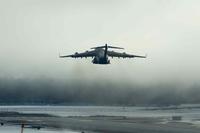 Russian leaders have taken notice of the U.S. Air Force's plans to build a next generation bomber announcing they have set their sites on building a hypersonic bomber.
Russian leaders have taken notice of the U.S. Air Force's plans to build a next generation bomber announcing they have set their sites on building a hypersonic bomber.
Russian Deputy Prime Minister Dmitry Rogozin said his country won't settle for a bomber like the B-2. Air Force leaders want to pursue the same hypersonic technology the U.S. military is trying to develop.
Rogozin's comments come conspicuously close to a failed hypersonic test flight the U.S. Air Force held on Aug. 15. The test flight vehicle dropped into the Pacific Ocean 15 seconds after it was released from a specially outfitted B-52 and never reached the Mach 6 speeds U.S. Air Force officials had hoped.
To fly hypersonic means flying five times the speed of sound (Mach 5) or faster than 3,840 miles per hour.
The Russians hope to build their hypersonic bomber by 2020, Rogozin said. That timeline seems a bit ambitious if they are starting to develop the engines now.
The U.S. started its Waverider program in 2004 having spent $140 million. The Aug. 15 was the last test scheduled under the program. Pentagon officials will have to seek additional funding to continue the program.
Engineers built the X-51A Waverider's scramjet engine to fly without liquid jet propellant. The engine instead uses the oxygen in the air to propel it. It also harnesses the energy created by its own shock wave to reach top speeds up to Mach 6.
The U.S. Air Force had hoped to outfit an operational aircraft with hypersonic engines by 2016. Following this month's test failure and the questions over future funding, those goals are very much in doubt. For the Russians to design and deliver a hypersonic bomber by 2020, seems just as unlikely.
U.S. officials have not specified whether their own next generation bomber would fly hypersonic speeds. The U.S. Air Force said in 2007 the bomber would likely be subsonic to keep costs under control. Of course, the next generation bomber program has been scrapped and then brought back since then by the Pentagon.
However, it's hard to envision the U.S. fielding a hypersonic bomber in the next decade with the budget shortfalls they will experience the next five years. Not to mention the struggle they've had building the fifth generation fighter fleet.







